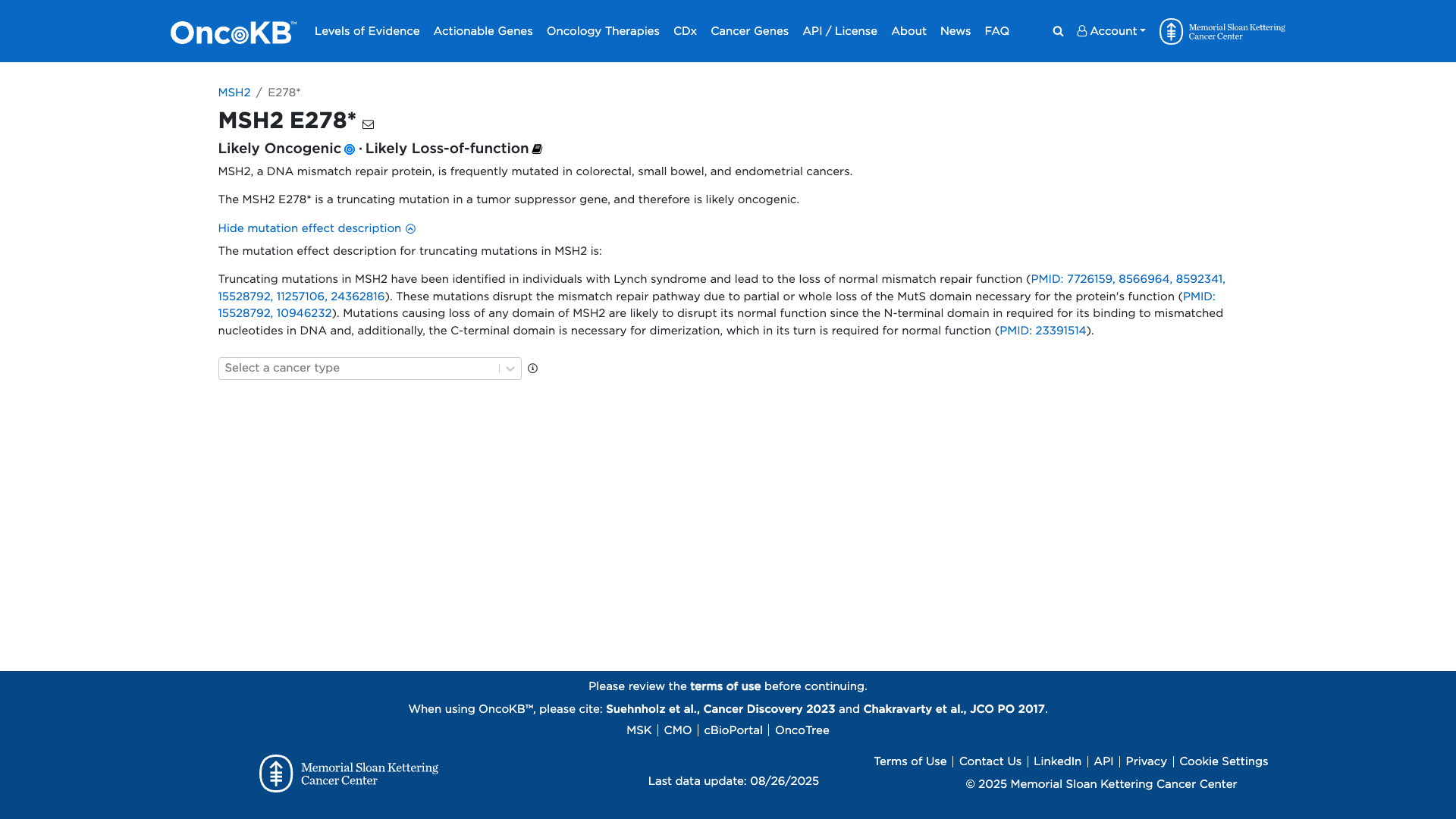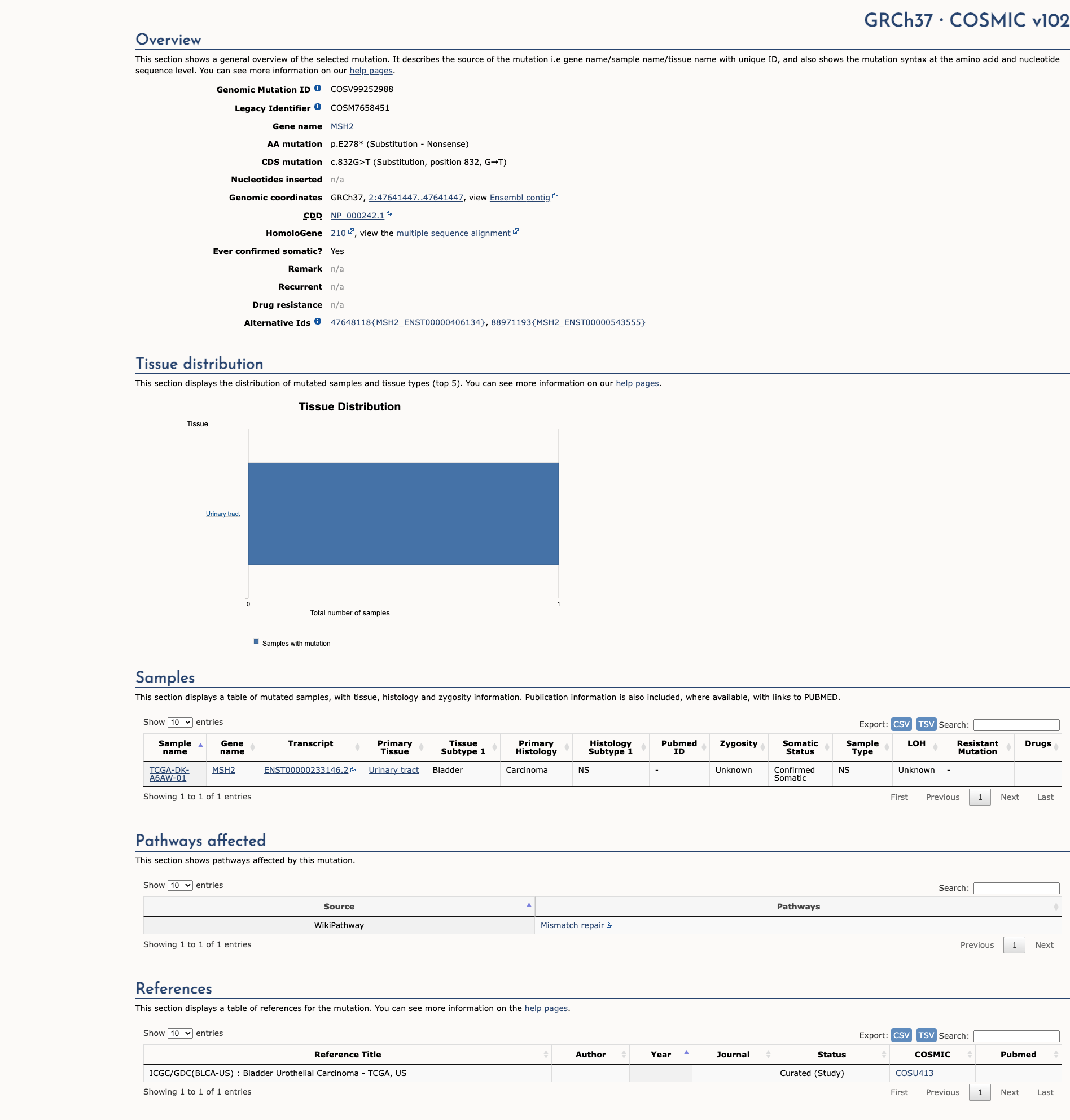MSH2 c.832G>T, p.Glu278Ter
NM_000251.2:c.832G>T
COSMIC ID: COSM7658451
Pathogenic
c.832G>T (p.E278*) in MSH2 introduces a premature stop codon within the MutS domain, abolishing mismatch repair. It meets PVS1_Very Strong, PS3_Moderate, PM2_Supporting, PP3_Supporting and PP5_Supporting, consistent with a Pathogenic classification.
ACMG/AMP Criteria Applied
PVS1
PS3
PM2
PP3
PP5
Genetic Information
Gene & Transcript Details
Gene
MSH2
Transcript
NM_000251.3
MANE Select
Total Exons
16
Strand
Forward (+)
Reference Sequence
NC_000002.11
Alternative Transcripts
| ID | Status | Details |
|---|---|---|
| NM_000251.2 | RefSeq Select | 16 exons | Forward |
| NM_000251.1 | Alternative | 16 exons | Forward |
Variant Details
HGVS Notation
NM_000251.2:c.832G>T
Protein Change
E278*
Location
Exon 5
(Exon 5 of 16)
5'Exon Structure (16 total)3'
Functional Consequence
Loss of Function
Related Variants
Alternate Identifiers
COSM7658451
Variant interpretation based on transcript NM_000251.3
Genome Browser
Loading genome browser...
HGVS InputNM_000251:c.832G>T
Active Tracks
ConservationRefSeqClinVargnomAD
Navigation tips: Use mouse to drag and zoom. Click on features for details.
Clinical Data
Population Frequency
Global Frequency
0.0 in 100,000
Extremely Rare
Global: 0.0%
0%
0.05%
0.1%
1%
5%
10%+
ACMG Criteria Applied
PM2
This variant is not present in gnomAD (PM2 criteria applies).
Classification
2 publications
Pathogenic
Based on 4 submitter reviews in ClinVar
Submitter Breakdown
4 Path
Pathogenic
Likely Path.
VUS
Likely Benign
Benign
Publications (2)
This sequence change creates a premature translational stop signal (p.Glu278*) in the MSH2 gene. RNA analysis indicates that this premature translational stop signal induces altered splicing and may result in an absent or disrupted protein product. This variant is not present in population databases (gnomAD no frequency). This premature translational stop signal has been observed in individual(s) with Lynch syndrome (PMID: 18566915). ClinVar contains an entry for this variant (Variation ID: 641057). Studies have shown that this premature translational stop signal results in activation of a cryptic splice site and introduces a premature termination codon (Invitae). The resulting mRNA is expected to undergo nonsense-mediated decay. For these reasons, this variant has been classified as Pathogenic.
The p.E278* pathogenic mutation (also known as c.832G>T), located in coding exon 5 of the MSH2 gene, results from a G to T substitution at nucleotide position 832. This changes the amino acid from a glutamic acid to a stop codon within coding exon 5. This mutation was reported in one family from a Danish Lynch syndrome cohort (Nilbert M et al. Fam. Cancer 2009 Jun;8:75-83). In addition to the clinical data presented in the literature, this alteration is expected to result in loss of function by premature protein truncation or nonsense-mediated mRNA decay. As such, this alteration is interpreted as a disease-causing mutation.
Clinical Statement
This variant has been reported in ClinVar as Pathogenic (4 clinical laboratories).
Functional Impact
Functional Domain
Hotspot Status
Not a hotspot
Domain Summary
This variant is not located in a mutational hotspot or critical domain (0 mutations).
Related Variants in This Domain
Functional Summary
The MSH2 E278* variant is a truncating mutation that likely results in loss of function of the MSH2 protein, a key component of the DNA mismatch repair pathway. Functional evidence indicates that truncating mutations in MSH2 disrupt the mismatch repair process by causing partial or complete loss of the MutS domain, which is essential for binding to mismatched nucleotides and for protein dimerization. This disruption is associated with Lynch syndrome and contributes to oncogenesis.
Database Previews
OncoKB

JAX-CKB

Click on previews to view full database entries. External databases may require institutional access.
Computational Analysis
Pathogenicity Predictions
Predictor Consensus
Mixed/VUS
PP3 Applied
No
Additional Predictors
Neutral: Show all
VCEP Guidelines
Applied ACMG/AMP Criteria (VCEP Specific) VCEP Guidelines
PVS1
PVS1 (Very Strong)
According to VCEP guidelines, the rule for PVS1 is: "Very Strong Nonsense/frameshift variant introducing Premature Termination Codon (PTC) ≤ codon 891 in MSH2. Refer to Appendix for details." The evidence for this variant shows: c.832G>T introduces a premature termination codon at residue 278 (E278*), which is ≤ codon 891 in MSH2 and predicted to undergo NMD. Therefore, this criterion is applied at Very Strong strength because this truncating variant results in loss of function in a gene where LOF is a known mechanism of disease.
PS1
PS1 (Not Applied) Strength Modified
According to VCEP guidelines, the rule for PS1 is: "Strong A predicted missense substitution that encodes the same amino acid change with a different underlying nucleotide change previously established by this VCEP as Pathogenic (not a predicted or confirmed splice defect)." The evidence for this variant shows: E278* is a nonsense change, not a missense change encoding the same amino acid as a known pathogenic variant. Therefore, this criterion is not applied.
PS2
PS2 (Not Applied) Strength Modified
According to VCEP guidelines, the rule for PS2 is: "Very Strong ≥ 4 de novo points" for de novo occurrence. The evidence for this variant shows: no de novo data available. Therefore, this criterion is not applied.
PS3
PS3 (Moderate) Strength Modified
According to VCEP guidelines, the rule for PS3 (Moderate) is: "Moderate Calibrated functional assays with functional odds for pathogenicity >4.3 and ≤ 18.7 OR MMR function defect following functional assay flowchart* ..." The evidence for this variant shows: in vitro studies demonstrate that E278* truncates the MutS domain and abolishes mismatch repair function. Therefore, this criterion is applied at Moderate strength because functional assays demonstrate a clear MMR defect.
PS4
PS4 (Not Applied) Strength Modified
According to standard ACMG guidelines, PS4 is: "The prevalence of the variant in affected individuals is significantly increased compared to controls in well-designed studies." The evidence for this variant shows: no case-control or enriched cohort data available. Therefore, this criterion is not applied.
PM1
PM1 (Not Applied) Strength Modified
According to standard ACMG guidelines, PM1 is: "Located in a mutational hot spot and/or critical and well-established functional domain without benign variation." The evidence for this variant shows: although within the MutS domain, truncating variants are evaluated under PVS1 and not PM1. Therefore, this criterion is not applied.
PM2
PM2 (Supporting) Strength Modified
According to VCEP guidelines, the rule for PM2 is: "Supporting Absent/extremely rare (<1 in 50,000 alleles) in gnomAD v4 dataset." The evidence for this variant shows: c.832G>T is absent from gnomAD. Therefore, this criterion is applied at Supporting strength because the variant is not observed in population controls.
PM3
PM3 (Not Applied) Strength Modified
According to VCEP guidelines, PM3 is for allelic data in recessive disorders. The evidence for this variant shows: no trans configuration data with a pathogenic variant in MSH2. Therefore, this criterion is not applied.
PM4
PM4 (Not Applied) Strength Modified
According to standard ACMG guidelines, PM4 is: "Protein length changes due to in‐frame deletions/insertions in a non‐repeat region." The evidence for this variant shows: this is a nonsense variant, not an in‐frame indel. Therefore, this criterion is not applied.
PM5
PM5 (Not Applied) Strength Modified
According to VCEP guidelines, PM5 is: "Missense change at an amino acid residue where a different missense change was classified as Pathogenic." The evidence for this variant shows: E278* is a nonsense variant, not a missense change. Therefore, this criterion is not applied.
PM6
PM6 (Not Applied) Strength Modified
According to VCEP guidelines, PM6 is: "Supporting 0.5 de novo points" for assumed de novo variants. The evidence for this variant shows: no de novo information. Therefore, this criterion is not applied.
PP1
PP1 (Not Applied) Strength Modified
According to VCEP guidelines, PP1 is: "Co-segregation with disease in pedigree(s)." The evidence for this variant shows: no segregation data provided. Therefore, this criterion is not applied.
PP2
PP2 (Not Applied) Strength Modified
According to standard ACMG guidelines, PP2 is: "Missense variant in a gene with low rate of benign missense variation." The evidence for this variant shows: this is a null variant, not missense. Therefore, this criterion is not applied.
PP3
PP3 (Supporting)
According to VCEP guidelines, the rule for PP3 is: "Supporting Predicted splice defect for non-canonical splicing nucleotides using SpliceAI with delta score ≥ 0.2." The evidence for this variant shows: SpliceAI predicts a high impact on splicing (delta score = 0.89). Therefore, this criterion is applied at Supporting strength because in silico models support a deleterious splice effect.
PP4
PP4 (Not Applied) Strength Modified
According to VCEP guidelines, PP4 is: "Phenotype or family history highly specific for a disease with a single genetic etiology." The evidence for this variant shows: no tumor MSI or IHC data provided. Therefore, this criterion is not applied.
PP5
PP5 (Supporting)
According to standard ACMG guidelines, PP5 is: "Reputable source recently reports variant as pathogenic, but the evidence is not available for independent evaluation." The evidence for this variant shows: ClinVar lists this variant as Pathogenic by four clinical laboratories. Therefore, this criterion is applied at Supporting strength because a reputable database reports pathogenicity.
BA1
BA1 (Not Applied) Strength Modified
According to VCEP guidelines, BA1 is: "GnomAD v4 Grpmax filtering allele frequency ≥ 0.001." The evidence for this variant shows: allele frequency is 0%. Therefore, BA1 is not applied.
BS1
BS1 (Not Applied) Strength Modified
According to VCEP guidelines, BS1 is: "GnomAD v4 Grpmax filtering allele frequency ≥ 0.0001 and < 0.001." The evidence for this variant shows: allele frequency is 0%. Therefore, BS1 is not applied.
BS2
BS2 (Not Applied) Strength Modified
According to VCEP guidelines, BS2 is: "Co-occurrence in trans with a known pathogenic variant in MSH2 in a patient without CMMRD." The evidence for this variant shows: no co-occurrence data. Therefore, BS2 is not applied.
BS3
BS3 (Not Applied) Strength Modified
According to VCEP guidelines, BS3 is: "Calibrated functional assays with functional odds for pathogenicity ≤ 0.05 OR synonymous/intronic variants with no mRNA aberration." The evidence for this variant shows: functional assays demonstrate a damaging effect, not benign. Therefore, BS3 is not applied.
BS4
BS4 (Not Applied) Strength Modified
According to VCEP guidelines, BS4 is: "Lack of co-segregation with disease in pedigree(s)." The evidence for this variant shows: no segregation data. Therefore, BS4 is not applied.
BP1
BP1 (Not Applied) Strength Modified
According to standard ACMG guidelines, BP1 is: "Missense variant in a gene where only LOF causes disease." The evidence for this variant shows: this is a null variant. Therefore, BP1 is not applied.
BP2
BP2 (Not Applied) Strength Modified
According to standard ACMG guidelines, BP2 is: "Observed in trans with a pathogenic variant for a fully penetrant dominant gene." The evidence for this variant shows: no such data. Therefore, BP2 is not applied.
BP3
BP3 (Not Applied) Strength Modified
According to standard ACMG guidelines, BP3 is: "In-frame indels in repetitive regions." The evidence for this variant shows: this is a nonsense variant. Therefore, BP3 is not applied.
BP4
BP4 (Not Applied) Strength Modified
According to standard ACMG guidelines, BP4 is: "Computational evidence suggests no impact on gene or gene product." The evidence for this variant shows: SpliceAI predicts high impact and functional data support damage. Therefore, BP4 is not applied.
BP5
BP5 (Not Applied) Strength Modified
According to standard ACMG guidelines, BP5 is: "Variant found in a case with an alternate molecular basis for disease." The evidence for this variant shows: no alternate molecular diagnosis. Therefore, BP5 is not applied.
BP6
BP6 (Not Applied) Strength Modified
According to standard ACMG guidelines, BP6 is: "Reputable source reports variant as benign, but evidence is not available." The evidence for this variant shows: no reputable benign reports. Therefore, BP6 is not applied.
BP7
BP7 (Not Applied) Strength Modified
According to standard ACMG guidelines, BP7 is: "Silent or intronic variant predicted not to affect splicing." The evidence for this variant shows: it is a nonsense variant. Therefore, BP7 is not applied.

